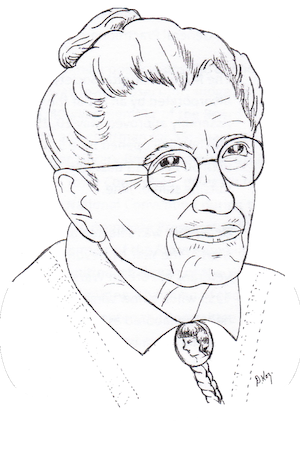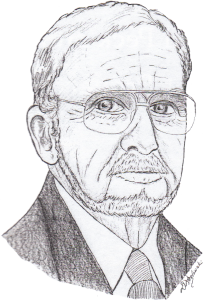a trail blazer in 20th century
Helen Parthenay Langner, who resided in Milford for an impressive seventy years, is renowned for a number of reasons. As the fourth woman to graduate from the Yale School of Medicine, she was one of the few women who broke the gender barrier that barred women from the field of medicine. Passing away due to natural causes on the 10th of December, 1997 at the age of 105, the centenarian is honored as Milford’s oldest resident at the time of her death. Most well-known for her many accomplishments or remarkable traits as a person, Dr. Langner is also truly famed for her prodigious impact on the “Small City with a Big Heart.” (ObitFinder 1)
Though Langner was the only daughter of six children, she got along well with all her five younger brothers in their residence at 1 Shipyard Lane, which was demolished in 2003 due to the condominium construction. She had a close relationship with her brother Gustave, a well-known swimmer. Because they lived near the water, she took an interest in sailing on Long Island Sound. As a child, Langner enjoyed listening to operas such as the Magic Flute and Die Fledermaus. According to John Curtis, the author of “A Life of Engagement,” when Langer was at Yale University, her mother “would slip her an extra dollar to attend a performance.” Her interest in operas would lead her to listen to operas every Saturday afternoon during her later years. In addition, her favorite classical music radio station was WQXR of the New York Times. Some of her favorites included Beethoven, Mozart, and the songs of Schubert. In fact, on Sundays, she would listen to classic jazz; although she did not really like it, she wanted to know more about it. Literature also intrigued Langner. So, she attended book discussions at a public library. (Sizer 1)
According to Patricia Rosenau, the author of the article “Doctor Looks Ahead to 65th Class Reunion,” Langner graduated from the old Milford High School in 1910, the first year that the school adopted a four-year curriculum. Langner’s father was a baker, a job which produces insufficient income to sustain Langner’s college tuition; hence, financial problems were prevalent as the time came for Langner to consider college. However, she excelled in academics to such an extent that she easily entered Hunter College without taking an entrance exam. She attended Hunter because at that time, no Connecticut college had broken the gender barrier. Immediately after her graduation in 1914, she became a high school biology teacher but felt it was not her true calling. While working in an admissions office at St. Luke’s Hospital in New York City, she considered training to be a nurse. Langner’s father, on the other hand, did not approve of the idea and wanted her to return home in order to attend the Yale School of Medicine, which had then begun to accept women. Her daily routine as a Yale graduate student involved her catching an early train from Milford to New Haven and walking from the Union Station to her classes. Upon returning home in the afternoon, she would immerse herself in serious study. (Sizer 1) (Curtis 3) (Rosenau 1)
Initially, Yale claimed that “the lack of proper bathroom facilities for women” was the impetus behind the gender barrier. But eventually, Henry Farnam, a Yale graduate and professor of economics, donated money to the institution to execute “suitable lavatory arrangements” (Wortman 2). Thus, Louise Farnam, his daughter, became the first woman to graduate from the Yale School of Medicine. Just two years later in the Class of 1922, Langner became the fourth woman to do so.
Moreover, she was the only woman in her medical school class. Since she was accustomed to being surrounded by five brothers, her interaction with male classmates was amicable; as a result, she did not think back on those days with bitter resentment toward the discrimination that she received. As a matter of fact, she looked up to her male classmates. For instance, classmates and twin brothers Edward and Maurice Wakeman—though the latter died after doing research in Africa— both maintained a particularly close relationship with Langner, even after graduation. This relationship is just one example of Langner’s compatibility with others. As stated by Rosenau, Langner had said that, “The men in charge supervised you and helped you along. We discussed each case at case conferences, and that’s when you learn the most.” In fact, a Yale professor recognized her talent and asked her to serve as a surgical intern for a month, where Langner felt the adrenaline rush as she rode the ambulance three times through New Haven. (Rosenau 2) (Curtis 3) (Wortman 1-2)
Langner’s inspiration stemmed from her interest in the natural sciences—anything that dealt with how the human body worked. She helped bring greater emphasis on Science which most likely became a greater focus in the curriculum due to the influence of the Women’s Christian Temperance Union, which warned people in school about the dangers of alcohol. Full of passion and ambition, she engrossed herself in physics, psychology, and anything else that captivated her. Fortunately, her hobbies turned out to be beneficial when these courses became medical school requirements.
Back when she was still employed as a clerk at St. Luke’s Hospital during World War I, she had received much hands-on experience when the laboratory employees allowed her to look at slides and even watch an operation. Simultaneously, as she continued her studies, Langner developed an interest in both psychiatry and pediatrics. However, she was further drawn to the field of psychiatry after she stumbled upon Clifford Beers’ book “The Mind That Found Itself,” in which the author discussed his recovery from his mental illness. She was so engaged in the book’s content that she finished it in two nights, putting aside her academic course work. Her public health professor, who had introduced Langner to the book, also led her to a paid job at Ward’s Island, a state mental hospital in New York. There, she learned how to administer ether, an inhalant anesthetic, and quickly moved up to the highest position that a woman could attain at the time: senior assistant physician. After her work at Ward’s Island, she received a National Committee for Mental Hygiene fellowship to the clinics of Cleveland, Boston, Chicago, and New York. Langner had a clear direction in life, for she knew she wanted to set up a child guidance clinic after her residency. However, with the prevailing gender discrimination, men were always preferred for such positions. Still, she persisted. Her two-year work at a child guidance clinic of the Indiana School of Medicine came to an end as the arrival of the Depression dissolved its funds. (Rosenau 2) (Curtis 3)
As a pioneer in the field of child psychiatry, she possessed something unique that drew children to her since she was “very approachable” (Curtis 4). In one particular instance, she treated a five-year-old boy with hyperactive symptoms by encouraging his curiosity. Langner did not view the boy as a patient; instead, she allowed him to explore every corner of her house as a welcomed guest, without restricted access. Though she never had children of her own, she had special bonds with them. One of her numerous patients was a ten-year-old boy with a tendency to daydream and poor hand-eye coordination. She played games with him in order to become familiar with his strengths and weaknesses. (Curtis 4-5)
The month Japan attacked Pearl Harbor, Langner opened her own private practice in New York City, where she was able to extend her influence. But, she retired from private practice in 1970 after being appointed to The New York Hospital-Cornell Medical Center. With a dedicated mind, Langner worked consistently into her nineties. (Letetia 82) (Curtis 4)
After working in the medical center, she was a consulting attending physician at Milford Hospital up until 1988 at age 96, and was honored as the oldest practicing psychiatrist in Milford. During her time at the original Milford Hospital Society, it consisted of “6 beds, several nurses and general practitioners”; by 1925 there were “25 beds, an ‘accident room,’ and a small operating room” (Letetia 82). Furthermore, when Langner worked there in the 1970s, extensive additions—still present today—were added to the hospital. Due to her constant presence in Milford Hospital, she confessed, “I guess I’m an institution there” (Adler 287). Milford City Clerk Alan Jepson recalled, “To see her there was to feel all was right with the world…as long as she was in it.” Although she stopped working for pay at the age of ninety-eight, George Kraus, director of the Milford Health Department, finally convinced her to allow him to pay for her licensing fees and professional dues while Langner was volunteering.
Langner’s interests were not confined to the medical field. In fact, as a feminist, she marched in women’s suffrage rallies. Yet, she never expressed hostility, for she once told Alvin V. Sizer, “I was never aggressive because I felt that if you bided your time, something would come up. I believe that if you live long enough you’ll automatically get recognition.” Wanting to improve women’s position in the world, she encouraged the idea of women breaking out of their separate spheres by integrating the concepts of family and profession. For instance, Langner “took over as director of undergraduate health services at Vassar College when her predecessor took a maternity leave” (Curtis 3). According to Curtis, Langner confided in Merle Waxman, the director of the Vassar College’s Office for Women in Medicine, telling Waxman that she would like to see more women participating in the field. In an interview with Sizer, Langner admitted that, “There were not too many women in psychiatry then and it was a good field for us because men were not so interested in it. One obstetrician told me he always thought that people who became psychiatrists were a little nuts.” Due to her past connections with sites such as the Long Island Sound and the old Milford High School, Langner also advocated the preservation of the coastline and historical buildings in her fight for the environment. (Curtis 2-3) (Sizer 1)
As a person, Langner was absolutely amiable. People sought her for advice on many personal problems including marital difficulties, trouble with employers, and depression. Langner tried to help out anyone as much as she could. In that capacity, she sacrificed her time and offered money to patients who needed financial support for psychiatric care. “I’ve never turned down anyone who wanted to see me,” Langner said as she reflected on her earlier experiences. (Sizer 1)
“I am not old! I don’t feel old! If someone asks me for particulars I just say that I have celebrated my 99th birthday,” the vigorous and optimistic Langner informed her New Haven Register interviewer, Sizer. The process of aging seemed to be invisible to Langner, for she was quite active during her senectitude. Langner often attended one or two conferences a week in order to stay up-to-date in science. Moreover, Langner continued to walk three-quarters of a mile daily from her “white two-story house” which “overlooked the harbor” to her volunteer work at Milford Hospital and the city health department (Curtis 2). Due to this, she contracted arthritis, causing painful knees. However, she did not let that hinder her life; instead she walked with a cane. Though others tried to offer her transportation to events, such as Yale reunions, Langner steadfastly refused and chose to walk to the town center where she would take the bus to New Haven. Aside from the pacemaker that she had for fourteen years—even at her age—she was relatively healthy with few health problems. Like other elderly persons, her eyesight and hearing abilities dwindled with passing age. In order to read, she had to rely on a magnifying lens. (Sizer 1) (Curtis 2)
Having lived for so many years, she had witnessed many memorable events, such as the sighting of Halley’s Comet, which “becomes visible to the unaided eye about every 76 years as it nears the sun” (Yeomans 1). In comparison to the past, Langner felt race relations in the twentieth century society have improved substantially. During World War I, Langner vividly remembered the discrimination that her German-born parents faced. Yet, Langner felt that some old values must be preserved. She reminisced about the moments when her family gathered around the dining table at dinner. While she felt that, back in the day, alcohol was society’s enemy, she considered drugs to be the problem in her day. (McCready 2) (Sizer 1)
During Langner’s time, women were usually forced to choose either marriage or a career. Langner never married, so she was able to both accomplish a prodigious amount of work in the medical field and represent women all over the nation. Honored as Yale Medical School’s oldest alumna, she died just a few months prior to her second medical diploma as a member of the Class of 1998, the first medical class with more women than men. Langner related to Sizer that at a hundred years of age, “I make myself climb a flight of stairs everyday. I believe in a sense of humor. I am an optimist. I make a point of hoping things will get better. I’m never bored or I just doze off. I try to cultivate the young, making up for the losses I have had. I’ve said for years I was going to live to be 100.” Having enjoyed life for 105 years, Langner claimed that her secret to longevity is having good reasons for living. Even though she is no longer physically present on the face of the Earth, according to Jepson, her influence remains in the Yale School of Medicine since she donated her body to it. An ordinary Milford resident and ambitious medical student, Langner had a perspective on life: “There is always more to do than you can do.” This philosophy on life should ring loud and true in all of our hearts. (Sizer 1) (Curtis 1-2)



